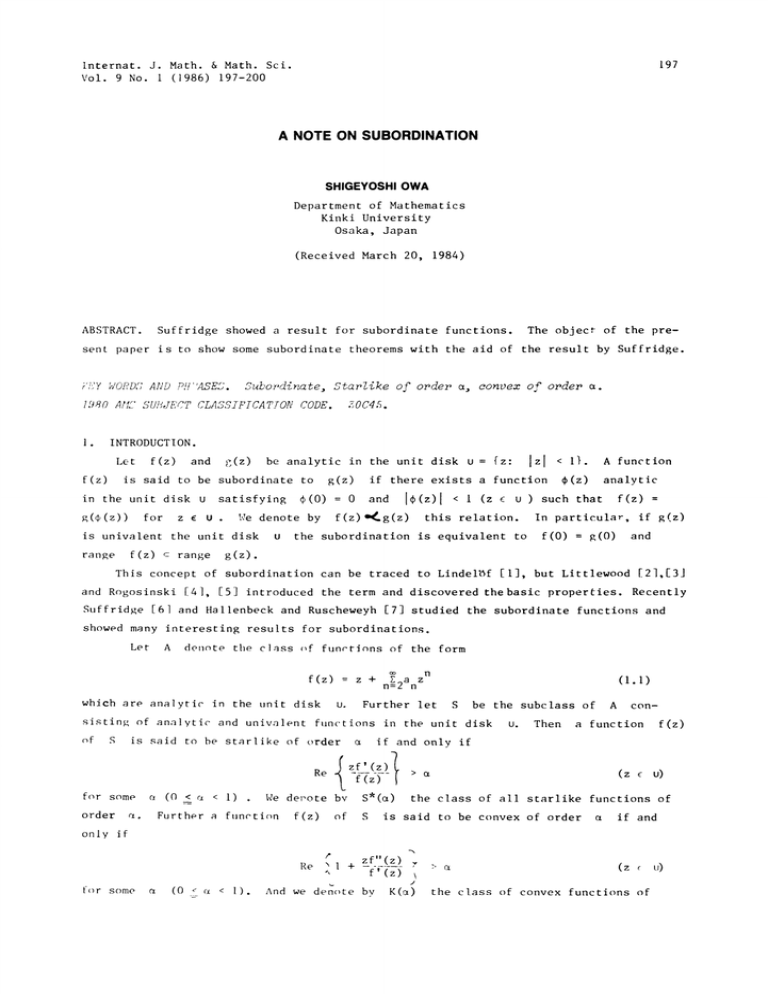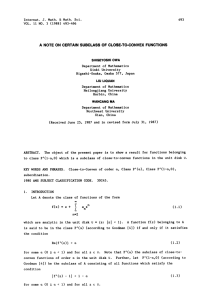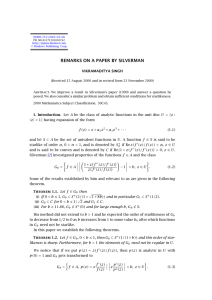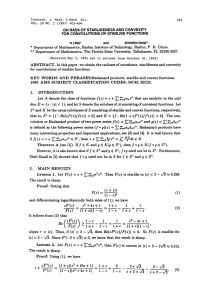Document 10507941
advertisement

Internat. J. Math. & Math. Sci.
(1986) 197-200
Vol. 9 No.
197
A NOTE ON SUBORDINATION
SHIGEYOSHI OWA
Department of Mathematics
Kinki University
Osaka, Japan
(Received March 20, 1984)
ABSTRACT.
Suffridge showed a result for subordinate functions.
The object of the pre-
sent paper is to show some subordinate theorems with the aid of the result by Suffridge.
1980 AMC SU/JECT CLASSIFfCATTON CODE.
1.
,
of order
Suboz, dinate, Starlike
A?JD P!!"ASEL’.
}’,’}Y WORD[;
convex
of order
ZOC45.
INTRODUCTION.
f(z)
Let
f(z)
and
g(z)
in the unit disk u
g(+(z))
satisfying
g(z)
is univalent the unit disk
f(z)
range
range
(0)
We denote by
z e
for
[z[
1}.
if there exists a function
(z)
analytic
such that
f(z)
{z:
be analytic in the unit disk
is said to be subordinate to
u
0
[(z)[
and
f(z)’g(z)
(z
this relation.
the subordination is equivalent to
In particular, if g(z)
g(O)
f(O)
and
g(z).
This concept of subordination can be traced to LindelBf
[_4], 5] introduced the
and Rogosinski
A function
[I], but Littlewood [2],[3]
term and discovered thebasic properties. Recently
Suffridge 6] and Hallenbeck and Ruscheweyh [7] studied the subordinate functions and
showed many interesting results for subordinations.
Let
A
denote the class ,f functions of the form
f(z)
which are ana|ytic in the unit disk
of
sistin
of
S
ana|vtic
for some
order
u.
(0
o
fr some
_
r
(0
Further let
I)
We depote
f(z)
Re
1).
c
S
be the subclass of
u.
Then
A
con-
f(z)
a function
if and only if
(z)
R
Further a function
onl if
(1 1)
a z
n=2 n
and univalent functions in the unit disk
is said to be starlike of order
__<_ ,
+
z
YzT-
t
by
S*()
of
S
(z
the class of all starlike functions of
is said to be convex of order
+ zf"(z)
f’ (z)
And we denote bv
K(a
u)
a
if and
(z
the class of convex functions of
u)
S. OWA
198
a.
order
S (a)
f(z)
it is well-known that
K(a)
S
S (0)
K, and
S (a)
The classes
K(a)
K(O)
S
K
O.
a
for
S * (a),
zf’(z)
if and only if
K(a) were first introduced by Robertson [8], and latter
and
[I0] and Pinchuk [II].
studied by Schild [9], MacCregr
z/(l-z)
classes defined by using the extremal function
Further, recently, some]
,
2(l-a)
S (a)
for
were
[12], Sheil-Small, Silverman and Silvia [13], Silverman and
Silvia [14], and Ahuja and Silverman [15].
studied by Ruscheweyh
Our main tool in this paper is the following result by Suffridge [15].
LEMMA.
Let the function
g(z)
the function
(z)-g(z),
f(t)
t
0
2.
dt
< I0 z
g(t)
r, 0
r
z: Izl
(r)
z
S*
be in the class
an
2
Z
n
If
be analytic in the unit disk u
f(z)
and
g(z), that is,
is subordinate to
then
iz
for
n
f(z)
dt
t
1}.
SUBORDINATION THEOREMS.
In this section, we show some subordination theorems with the aid of Lemma.
f’(re
Then
I"0
f(z)
Let the function
THEOREM i.
(0
I)
r
K(a).
u(r)
is contained in the image domain of the closed disk
4(a-l)/(l-z)
e
under the function
defined by (1.1) be in the class of
Further it lies for
r
# 0
on the boundary of
of this image domain if and only if
,:z e4(l-a)/(1-et)dt.
f(z)
(2.1)
0
where
PROOF.
f(z)
Since
is in the class
zf"(z)
f’(z)
Re
Note that
function
zf"(z)/f’ (z)
z/(l-z)
2
2a2z
+
K(a),
> a
f(z) satisfies that
-I
(z
is analytic in the unit disk
is starlike with respect to the orgin and
Re
u)
H, and that the
{z/(l-z) 2}
-I/4.
Hence we have that
z
f"(z)
(z)
4(l-a)z
Consequently, by using Lemma, it follows that
domain of
u(r)
under the function
# 0
f’(re
e
log f’(re
f’(re i8)
Thus we can see that
io)
if and only if
hence further f(z)
the theorem.
i,-
U).
to be that
lies for
4 (a-l) (l-z).
on the boundary of the image domain of
u(r) under e
0 on the boundary of the image domain
lies for r
4(a-l) (l-z)
6
is contained in the image
4(a-l)/(l-z), where log is understood
branch which vanishes at the point one.
r
(Z
(1_z)e
zf"(z)
f’k:’)
4(l-a)ez
u(r)
Further
under
(ll
(1_Z)2
the function of the form (2,1),
This completes the proof }f
NOTE ON SUBORDINATION
THEOREM 2.
Let the function
i0)/re
Then
f(re
u(r)
under
i0
(0 __< r < I)
the function
e
f(z)
PROOF.
Since
4(-I) (l-z)
S*(a),
f(z)
f(z)
ze
tion
4(l-a) / (l-ez)
2
I[
I.
> a
(z
is analytic in the unit disk
u
u.
u)
Hence
under the func-
that is
zf’ (z)
f(z)
By virtue of Lemma,
on the boundary
where
takes values in the image domain of the unit disk
4(l-a)z/(l-z)
S*(=).
satisfies that
zf’(z)
f(z)
zf’ (z)/f(z) -I
a2z +
zf’ (z)/f(z)
r# 0
Further it lies for
Re
and the function
(l.I) be in the class
defined by
is contained in the image domain of the closed disk
of this image domain if and only if
f(z) e
199
4(l-a)z
I<
(l-z) 2
we observe that
in the image domain of
log
f(rei)/re I
4(a-l)/(l-z)
under
u(r)
(z e U).
(0
r < I)
is contanined in
and it lies for
r
# 0
on the
boundary of this image domain if and only if
hence further,
f(z)
ze
zf’(z)
4(1-a)ez
f(z)
(l_ez) 2
4 (l-a) (1-ez)
Then
f(re io)
Let the function f(z)
(0
__<
r < 1)
f(z)
defined by
satisfying
We note that the function
image domain of the unit disk
class
S*.
of Theorem
Therefore
we’can
with the aid of
Re{zf’(z)}
zf’(z)
z
+
u under the function
0
2a2z2
0).
a(a
> a
is contained in the image domain of the closed disk
-4a/(1-z). Further it lies for r
if and only if f(z) =-4a/(l-z), where le =I.
PROOF.
Re{zf’(z)}
(LI) satisfy
under the function
main
I)
This gives the result we require.
Finally we show a theorem for functions
THEOREM 3.
(lel
(a>O).
u(r)
on the boundary of this do-
+
takes values in the
-4az/(l-z) 2
which belongs to the
prove the theorem by using the same technique as in the one
Lemma.
REPERENCES
I.
2.
3.
LINDELOF, E.
Mmoire sur certaines ingalits dans la thorie des fonctions monognes et sur quelques proprits nouvelles de ces fonctions dans le voisinage
d’un point singulier essentiel, Acta Soc. Sci. Fenn. 35 (1909), 1-35.
LITTLEWOOD, J.E. On inequalities in the theory of functions, Proc. London Math.
Soc. 23 (1925), 481-519.
LITTLEWOOD, J.E.
Lectures on the theory of functions, Oxford
London, 1944.
4.
ROGOSINSKI, W.
On subordinate functions, Proc.
1-26.
Cambrid
Universit Press,
Philos. Soc. 35 (1939),
5.
ROGOSINSKI, W. On the coefficients of subordinate functions, Proc. London Math.
Soc. 48 (1943), 48-82.
6.
SUFFRIDGE, T.J. Some remarks
(1970), 775-777.
on convex maps of the unit disk, Duke Math. J. 37
200
S. OWA
7.
HALLENBECK, D.J., and RUSCHEWEYH, St. Subordination by convex functions, Proc.
Amer. Math. Soc. 52 (1975), 191-195.
8. ROBERTSON, M.S. On the theory of univalent functions, Ann. Math. 37 (1936), 374408.
9. SCHILD,A. On starlike functions of order a, Amer. J. Math. 87 (1965), 65-70.
I0. MacGREGOR, T.H. The radius of convexity for starlike functions of order I/2, Proc.
Amer. Math. Soc. 14 (1963), 71-76.
II. PINCHUK, B. On starlike and convex functions of order a, Duke Math. J. 35 (1968),
721-734.
12.
RUSCHEWEYH, St.
13.
SHElL-SMALL, T., SILVERMAN, H. and SILVIA, E. Convolution multipliers and starlike
functions, J. Analyse Math. 41 (1982), 181-192.
14.
SILVERMAN, H. and SILVIA, E. Subclasses of prestarlike functions, (to appear).
AHUJA, O.P. and SILVERMAN, H. Convolutions of prestarlike functions, Internat. J.
Math. Math. Sci. 6 (1983), 59-68.
15.
Linear operators between classes of prestarlike functions, Comm.
Math. Helv. 52 (1977), 497-509.




